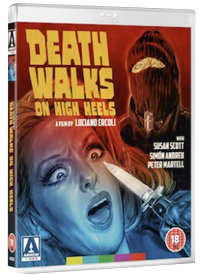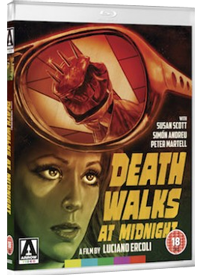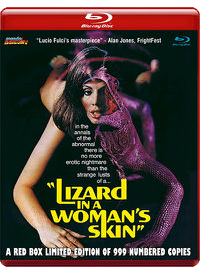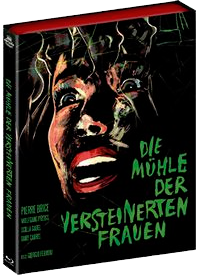
[
11]
Death Walks On High Heels
Every frame of Luciano Ercoli’s Death Walks On High Heels feels painstakingly composed, the cinematography arresting in both its beauty and ability to convey intrigue. Shots through windows and door-frames, a keyhole, a spyglass, all leave the viewer with a voyeuristic feeling, almost predatory, as if supplanting us in a role of someone with ill intent. There’s a pulp quality to the film, it’s littered with over the top stereotypes and caricatures, several characters wouldn’t be out of place in a Bond film, an eye-patched jewel thief or a prosthetic armed cat-carrying cross dresser. Ercoli’s wife Nieves Navarro is completely entrancing in the role of Nicole, parading a stunning assortment of outfits. Ercoli embodies the film with a sense of humour, from the Inspector’s bungling assistant, amusing fight scenes featuring karate chops, the two pub gossips to bizarre character names like 'Pennypacker'. There’s the typical assortment of red herrings and twists, and it all neatly ties together so perfectly. I’m always amazed the film isn’t more highly regarded; Ercoli juggles so many elements, tropes and even genres and crafts them with such a visually captivating style.





[
12]
Death Walks At Midnight
Luciano Ercoli’s Death Walks At Midnight is a sort of spiritual successor to his prior film Death Walks On High Heels, with many of the cast and crew returning, including Ercoli’s wife Nieves Navarro, screenwriter Ernesto Gastaldi, and cinematographer Fernando Arribas. The concept is fascinating, Nieves plays Valentina, a model that takes an experimental drug for an article and witnesses a murder in the apartment complex opposite. The murder seemingly took place six months ago, which creates an engaging mystery. It’s not as intricately plotted or as dexterously woven as Death Walks On High Heels, but it delivers the formula with a nimbler pace. There’s a higher body count, and it’s bloodier, but the characters are just as over the top, and it still has that comical edge, with the bungling inspector who doesn’t believe there even is a murder case. Nieves plays a far more independent and fierce character than in the prior film. The cinematography is a particular highlight, the scenes just as immaculately constructed and salient. The opening murder is striking, particularly the spiked iron glove and that dead-behind-the-eyes look on the victim, and there’s a really effective asylum scene. The film culminates with a breathtaking series of hyper-stylised action scenes that are a genuine joy to behold.





[
13]
Lizard In A Woman's Skin
Lucio Fulci’s Lizard In A Woman’s Skin is a heady, stylish experience. Laced with hypnotic dream sequences, it has a hallucinogenic quality. The dreams are so dramatically contrasting, from the lusty sexually fuelled and vice ridden, to a kind of claustrophobic miasma of nakedness. Florinda Bolkan’s character Carol is haunted with nightmares, visiting a psychologist to make sense of her delirium. In one prophetic nightmare she murders her neighbour after a sexually charged encounter, when her neighbour is later discovered dead, the lines blur between dream and reality. There’s a momentous sequence beginning in the cellar of an abbey that culminates on the roof, a succession of breathtaking scenes that elevates Lizard into something beyond the confines of its genre. Essentially a commentary on class divide, Lizard In A Woman’s Skin is reminiscent of Fulci’s Don’t Torture A Duckling, melding a compelling narrative with stunning set pieces.





[
14]
Mill Of The Stone Women
There are some films you just know you’re going to love. From the moment I became aware of Mill Of The Stone Women, I knew this would be a film that would resonate with me. I felt drawn to it, the film’s title, artwork, synopsis and trailer, each propelling me further under its spell. The rural gothic setting, the decrepitude of the Mill itself and the creaking mechanisms, the macabre carousel and it’s dark secret, the statues and mannequins, all create a baleful atmosphere. Even a shot of a spiral staircase gives a sense of dread, looking angular and foreboding. The setting is brilliantly realised, the carousel an exhibit of female mal-intent, featuring women of notoriety, criminals and murderers but in itself an exploitation, not just of those depicted, but those under the surface. The owner of the Mill’s daughter Elfie, played by Scilla Gabel, bears an uncanny resemblance to Barbara Steele, almost as if she’s been made up to look specifically like her. Like the carousel the film trundles, as if mechanised by wood, string, and stone. There’s a dark heart, shades of Eyes Without A Face and Gaslight, an unmistakeable power, one I cannot quite articulate, but am compelled by.



